Manage recharge and salinity – South Coast Sandplain WA
The issue – recharge and salinity
Salinity threatens approximately 82,300ha of the South Coast Sandplain zone in WA. While being a large area this represents only 2.7% of the total area contained within the south coast Sandplain (DAFWA, 2008).
Areas affected by secondary salinity have had loss of pasture production (especially in salt sensitive pasture species, such as clover) and reduced or failed crops. This poor plant growth results in bare ground exposed to wind and water erosion and the invasion of salt tolerant weeds such as barley grass, button weed and in severe cases samphire. Nutrient imbalances or deficiencies in affected soil further reduce plant growth. High salt levels lead to soil structure decline and a range of environmental problems, such as saline waterways that affect aquatic life.
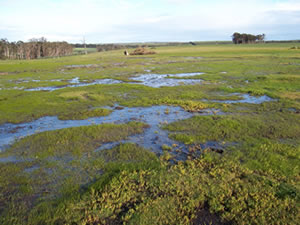
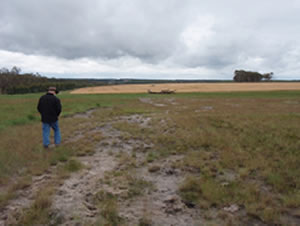
The cause – understanding catchment processes
[expand title=” ” swaptitle=” ” tag=”h4″ elwraptag=”div” elwrapclass=”expend-collapse-wrapper”]
Salinity management has in the past focused on recharge control. This refers to the planting of perennial pastures, shrubs and vegetation higher in the landscape to reduce the amount of water that is escaping the rootzone of the annual plants.
This approach is predicated on the ability of perennial plants to utilise large amounts of soil water. It also assumes that it is feasible to have enough area under perennial plants to reduce recharge significantly and have an impact on salinity. We know that in reality this is not always possible or feasible.
The impact of recharge control will depend on a number of complex interrelating issues related to soils, rainfall, landscapes and aquifers. In particular the size of the aquifer is crucial in determining the likelihood of recharge control having any measureable impact. Ground water systems can be broken into three broad classifications,
- Local flow systems – groundwater flows over distances less than 5km
- Intermediate flow systems – groundwater flows over distances 5 to 30km , and
- Regional flow systems – groundwater flows over distances more than 50km
We now know that ameliorating salinity is more than simply recharge control. Salinity management requires an integrated approach to landscape water control. Each catchment is unique so it cannot be assumed that we can simply translate our understanding of one particular landscape to others. The manifestation of salinity in each region is linked intimately to the groundwater processes prevailing within that region (such as size of the aquifers, how readily they transport groundwater, amount of salt stored in the soil profile and their storage capacity), and relationships with regional landscapes. Only when these relationships are understood can informed salinity management planning occur.
Importantly though, there is now a recognition that effective recharge control is generally difficult to achieve in the intermediary and large regional groundwater flow systems such as the sandplain/tertiary sediement landscapes of the south coast sandplain zone. These systems require regional scales of adoption for recharge control to be effective; and the outcomes may not be delivered for many decades due to the built-in inertia and slow responsiveness of these systems. In such circumstances, adaption in the form of the adoption of saltland agronomy systems may be more feasible and effective. . (Refer to Managing saline discharge areas, below)
To better understand the mechanisms that drive dry land salinity in the region go to Albany Hinterland, Wilson Inlet, Oyster Harbour and Esperance Sandplain catchment appraisal resource management technical reports.
[/expand]
The options – managing recharge
Addressing recharge with summer active perennials
[expand title=” ” swaptitle=” ” tag=”h4″ elwraptag=”div” elwrapclass=”expend-collapse-wrapper”]
Pastures for sheep and cattle in southern Australia have traditionally been based on annual ryegrass and subterranean clover. Almost all their growth occurs from the autumn break in mid-April until pastures dry off in mid-December. As a result any rainfall occurring out of this growth window will contribute to recharge.
Perennial pastures and shrubs have generally deeper root systems and are able to respond to rainfall whenever it falls. As a result they are generally able to create larger soil water buffers then traditional annual pastures and crops.
[/expand]
The three criteria for achieving recharge reduction with summer actives
[expand title=” ” swaptitle=” ” tag=”h4″ elwraptag=”div” elwrapclass=”expend-collapse-wrapper”]
Past experiences and research in WA has indicated the capacity of perennial plants to reduce recharge is based on three main factors. These are;
- Summer activity;
- Persistence under grazing (maintaining density); and
- Rooting depth.
There are many perennial pastures however not all are able to utilise substantial amounts of out of season rainfall. Those that have the potential to include lucerne, chicory, kikuyu and other subtropical grasses like gatton panic and setaria and summer active tall fescue. These remain green through the summer period and can extract water to a greater depth than annual species. Higher water use during summer and deeper rooting characteristics suggest they reduce leakage below the root zone (recharge). For example, lucerne roots can grow to three metres deep, drying the soil profile to at least five metres (table 1). Monitoring in WA showed that kikuyu and lucerne could dry the profile to at least 3m with sub clover reaching 98cm (DAFWA – unpublished 2003)
Table 1: Maximum depth (m) of soil moisture extraction for each species during the trial. Note species with the same letter are not significantly different (p>0.05) while species with different letters are significantly different (p<0.05). (DAFWA 2003, unpublished)
| Species | Depth (cm) |
| Sub-clover | 98 E |
| Currie cocksfoot | 142 DE |
| Prosper tall fescue | 156 CDE |
| Fraydo tall fescue | 156 CD |
| Tanit tall fescue | 170 CD |
| Atlas phalaris | 180 CD |
| Tyrell tall wheat grass | 191 CD |
| Holdfast phalaris | 203 CD |
| Au triumph tall fescue | 215 BCD |
| Rhodes grass | 266 BC |
| Kikuyu | >290 A |
| Lucerne | >290 A |
| LSD (5%) | 69 |
In the Triple System at the Hamilton EverGraze Proof Site, lucerne reduced recharge by 80 mm/yr compared to ryegrass pastures on well drained crests, and summer active tall fescue on clay flats reduced recharge by up to 60 mm/yr compared to ryegrass pastures.
Lucerne, kikuyu and the fodder shrub tagasaste are most likely the only perennial fodder plants/pastures that fulfil the three criteria for recharge control (Table 2). Species such as chicory, gatton panic, setaria and rhodes grass have the potential to reduce recharge but by how much is unknown. Other perennials like perennial rye grass, tall fescue, phalaris and cocksfoot have either a shallower root system, lack summer activity or do not persist under WA conditions.
Table 2 – Pasture species characteristics relevant to recharge control (see Perennials rules of thumb for WA)
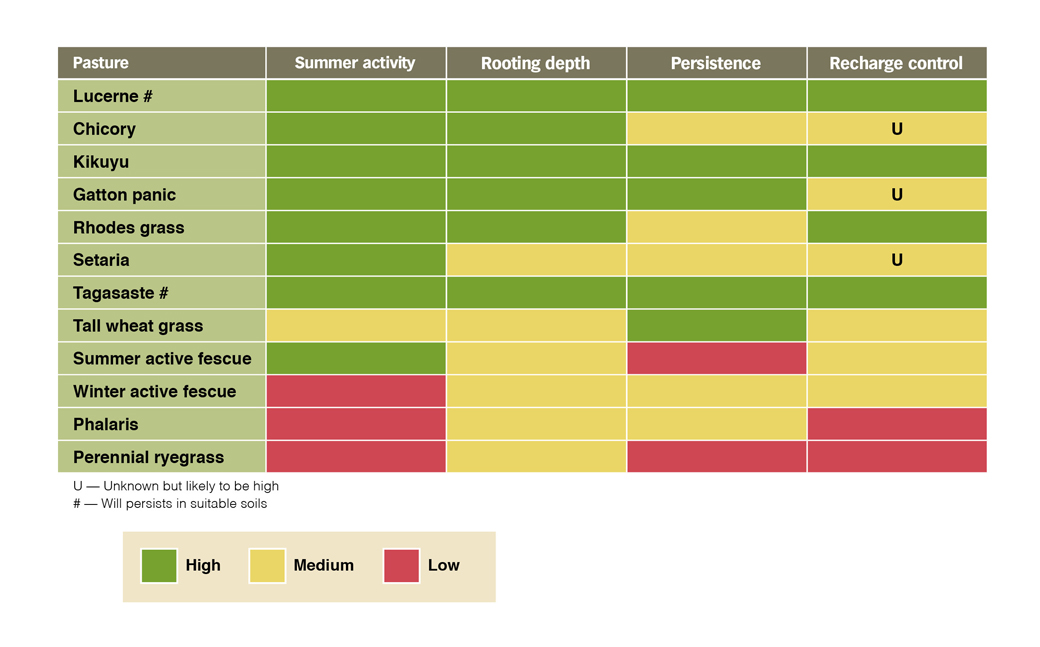
Selecting the right summer active
[expand title=” ” swaptitle=” ” tag=”h4″ elwraptag=”div” elwrapclass=”expend-collapse-wrapper”]
Kikuyu, Lucerne and tagastaste and possibly rhodes grass, setaria and gatton panic appear to be the most effective pasture species for managing recharge. The question that needs to be answered first is whether this plant is suited to the site and conditions required.
Lucerne is a proven performer when it comes to recharge control and can increase the soil water deficit above annual systems by as much as 81mm. It requires well drained soils with a pH above 4.8, which can limit its suitability in some areas (DAFWA 2009) and requires more careful management for persistence. It has the advantage of being able to be phase farmed in rotation with crops. This can be very effective at controlling recharge while still allowing cropping.
Kikuyu is acid tolerant and suited to the sandy and gravely soils with pH’s as low as 3(CaCl). It has high persistence and will tolerate waterlogging. Its forage value is not as high as plants like lucerne but the high out of season production and very good persistence under grazing makes it a popular choice among producers. There is also the potential for it to be overcropped with crops and annual pastures. This has huge potential in the south coast Sandplain and is an area of current and future work (DAFWA, 2006.
Tagastaste is not waterlogging persistant and requires well drained sandy soils. It is highly acid tolerant and will persist well on deep sandy soils. It has been grown for some time in WA. On the South Coast it is a species that is planted on deep sand sheets to stabilise soils and provide out of season feed. The lower quality of the forage (leaf and twigs combined) means that it should be combined with a better quality feed, either in the understory or in adjacent paddocks).
Selecting the right combination of plants must also consider the needs of the livestock production system, and individual management requirements of each plant variety. The management of summer active perennials will also influence the degree to which they are able to control recharge. For example, rotational grazing of lucerne is required to enable it to persist at sufficient densities to extract the stored winter surplus during the following summer (DAFWA, 2006).
Further information on selecting pastures for place and purpose can be found under Feedbase Options and on the Albany EverGraze Research pages.
[/expand]
Addressing recharge with shrubs at the break of slope
[expand title=” ” swaptitle=” ” tag=”h4″ elwraptag=”div” elwrapclass=”expend-collapse-wrapper”]
As discussed in the above section ‘Understanding catchment processes’, in local flow systems groundwater may flow less than 5km with excess water accumulating in the lower parts of the landscape where it mobilises salt. Preventing the movement of water down slope is one way to mitigate this form of salinity. One option to achieve this is to establish shrub belts or alleys along the contour to create dry soil buffers that are capable of absorbing water flowing down slope as either surface flow or sub surface flow across the soil A/B horizon interface.
Research work in WA has shown that tree or shrub belts will dry the profile under the plants and maybe a few metres out into the paddock. Unfortunately they have little impact outside of these zones in the interrow and as a result the impact on recharge and salinity is minimal. A project conducted by Department of Agriculture and Food WA showed that the main factor affecting the control of recharge is the amount of the catchment under perennial vegetation. Alley farming has less than 50% of a given area under perennial vegetation and in most cases far less. This appears to be inadequate to control the recharge and therefore the salinity in even small scale ground water systems.
The Wagga Wagga EverGraze Proof Site tested the effectiveness of shrub belts at break of slope and concluded the following:
- The shrubs used more water than annual pastures and therefore created a small dry soil buffer in the area where they were planted. However, the area sown to shrubs was not large enough to significantly reduce soil moisture at the foot of the slope, ie recharge control.
- Lucerne and the shrubs used similar quantities of water, and because lucerne was sown throughout the paddock, it had a significant effect on soil water at the foot of the slope. That is, lucerne pasture without shrubs would provide recharge control similar to lucerne with shrub belts.
- Shrubs had no impact on pasture growth. So soil moisture in the pasture areas between the shrub belts was largely unaffected and therefore had no impact on pasture growth, but no recharge control either.
- The evidence from the research and the EverGraze Proof Site does not support the use of shrub/tree belts for recharge control in environments such as those in the Albany Sandplain and Wagga. Farmers however should not discount planting shrubs and trees for other reasons such as discharge management, livestock shelter and biodiversity (DAFWA 2008) .
Identifying and adapting to salinity
| In addition to information provided below, Saltland Genie uses the latest knowledge and tools for salt-land management from the Sustainable Grazing on Saline Land initiative to compare the pros and cons of 11 possible options to manage saline land for a unique farm scenario. The tool also provides case study examples for what has worked for others. |
Measuring salinity
[expand title=” ” swaptitle=” ” tag=”h4″ elwraptag=”div” elwrapclass=”expend-collapse-wrapper”]
EC (electrical conductivity): Salinity is measured by the ability of water to conduct an electric current. Increasing salt in water or soil increases conductance. Distilled water has an EC of less than 0.0001 deciSiemens per metre (dS/m), and seawater 55 dS/m. Some laboratories report conductivity in different units, and conversions are shown in Table 1.
EC 1:5 is reported as part of standard soil analyses. It is the most routine measurement of salt content, but is affected by any particles in the water suspension including dispersed clay and organic matter.
ECe is the electrical conductivity of water within the soil when the soil is saturated with water, and is thus a more direct measure of soil salinity. However it is a more difficult procedure and not carried out routinely. Approximate conversions between EC 1:5 and ECe are shown in Table 1.
EM: Electromagnetic signals provide an indication of where a salt problem is likely to arise in the future, and is useful in fencing saline areas. An EM38 held horizontally detects salts in the top 40 – 50cm, and if held vertically 1 m.
Table 1. Conversion table for salinity units
| To convert | to | multiply by |
| millisiemens per centimetre (mS/cm) | decisiemens per meter (dS/m) | 1 |
| millisiemens per metre (mS/m) | decisiemens per meter (dS/m) | 0.01 |
| microsiemens per centimetre (µS/cm) | decisiemens per meter (dS/m) | 0.001 |
| EC 1:5 sand | ECe | 14 |
| EC 1:5 loam | ECe | 11 |
| EC 1:5 clay | ECe | 8 |
Salinity varies through the year
[expand title=” ” swaptitle=” ” tag=”h4″ elwraptag=”div” elwrapclass=”expend-collapse-wrapper”]
Values of EC 1:5 and ECe change about three-fold during the year, depending on the soil type and the amount of groundcover present. Salt concentrations in the topsoil are highest at the end of summer because soil evaporation concentrates salts toward the surface. Salinity drops during winter as rainfall flushes the salts deeper, thus winter-growing plants avoid the highest levels of salinity. The best time to measure soil salinity is between November and March, because it is relatively stable, and indicates the highest levels the plants will be exposed to.
[/expand]
Recognising dry land salinity
[expand title=” ” swaptitle=” ” tag=”h4″ elwraptag=”div” elwrapclass=”expend-collapse-wrapper”]
Soil salinity can be determined precisely by soil tests or subjectively through observation of salt-tolerant plant species.
A paddock walk is a quicker and cheaper way of assessing salinity than soil testing or electromagnetic (EM) surveys. The presence of salt indicator species allows classification into a 4-class system, which is the first step in deciding management options.
Previous work by the SGSL program broke saline land into four main categories. This allowed producers to identify which areas were going to be most profitable and what management and plant species should be considered. These classes are identified in Table 3
Table 3: Soil salinity classes, indicator species and options (Saltland Scoring and Solutions 400-600 and Saltland Scoring and Solutions >600.
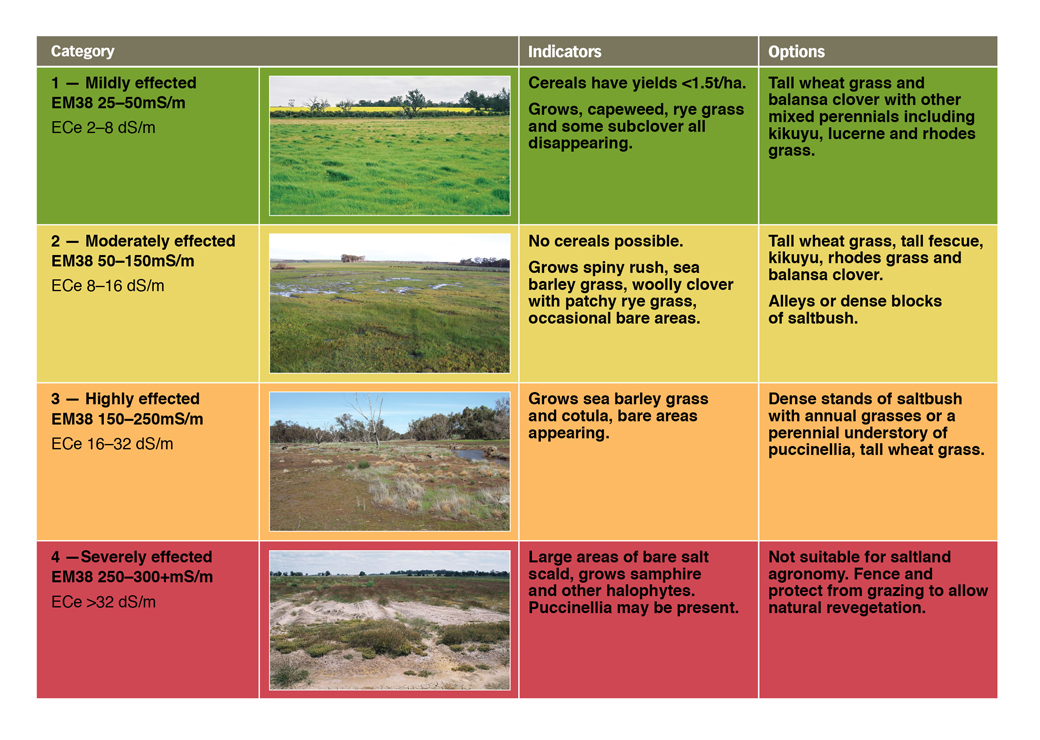
The severity of salinity and how it affects plant species is a combination of soil type, soil salinity level and waterlogging. Plants will often be able to tolerate surprising high soil salinity levels if no waterlogging is present. Once waterlogging occurs then most plants ability to tolerate salinity drastically decreases. Using an EM38 or taking soil salinity measurements in summer will give you an indication of the soil salinity. However the degree to which the site is waterlogged and for how long should also be considered (see SALTland Genie).
For further information on indicator species refer to the Saltland Scoring 400-600 and Saltland Scoring >600 publications and SALTdeck on SALTland genie
[/expand]
The options – pasture management for saline land
[expand title=” ” swaptitle=” ” tag=”h4″ elwraptag=”div” elwrapclass=”expend-collapse-wrapper”]
Separate fencing of saline land is the first step to improving its growth and utilisation, because unless fenced separately, sheep tend to overgraze saline land. The next step is to either manage the volunteer species or sow a new pasture. Options for management of saline land are explored in the Saltland Scoring and Solution 400-600mm and Saltland Scoring and Solution >600mm
[/expand]
Introduced species for saline land
Grasses
[expand title=” ” swaptitle=” ” tag=”h4″ elwraptag=”div” elwrapclass=”expend-collapse-wrapper”]
Tall wheatgrass (Thinopyrum ponticum) is a productive perennial grass tolerant of Class 1, 2 and even 3 salinity. It has been the dominant sown pasture species on saline land in Western Australia. The current variety Dundas, was selected for improved leafiness and digestibility over the previous variety, Tyrell though both are still planted. Many producers harvest their own seed which brings the establishment cost down considerably (SALTland Genie)
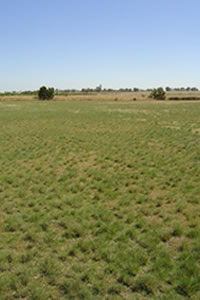
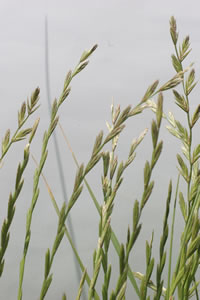
Saltland Genie case study farms in Cranbrook showed huge benefits from establishing saltbush alleys and tall wheat grass. This system has stabilised and in some cases reduced soil salinity and provided invaluable green feed during summer and autumn along with an invaluable source of vitamin E. More case studies can be found on SALTland genie for Tenterden, Cranbrook, Tambellup, Borden and Ravensthorpe.
Puccinellia (Puccinellia ciliata) is a fine-stemmed perennial grass tolerant of Class 2 – class 3 and even 4 salinity, and more tolerant of flooding than tall wheatgrass. It is easily established and grows mainly during winter and spring, but will stay green during summer if there is subsoil moisture (SALTland Genie)
Tall fescue (Festuca arundinacea) is a perennial grass tolerant of Class 1 salinity. Winter active varieties appear to be more hardy for WA conditions
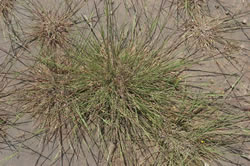
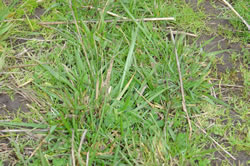
Kikuyu (Pennisetum clandestinum) is a creeping subtropical grass common across the south coast of WA. It is highly waterlogging tolerant and because of this is able to tolerate low levels of salinity (class 1-2 salinity). Kikuyu is renowned for being extremely tolerant of heavy grazing due primarily to rhizomes that spread out below the soil. Mor information can be found in EverGraze Action – Growing and using kikuyu in WA
Rhodes grass (Chloris gayana) is creeping stoloniferous subtropical grass that has been planted in various areas across WA. It was more common but has often been displaced by kikuyu. It is reputed to be more salt and drought tolerant then kikuyu, however its lack of waterlogging tolerance puts it at risk in many saline areas. It has been generally planted as part of mixes in mildy to moderately effected saline areas (class 1-2)
Saltbush (Atriplex species) is a halophytic shrub commonly planted on saltland throughout WA. There are several species planted however arguable the most common species are the Old Man (Atriplex nummularia) and River saltbush (Atriplex amnicola). Saltbush will provide out of season feed and is a rich source of vitamin E. In moderate to highly effected saline areas (class 2-3) it is capable of creating environments where good understory growth is possible. Other species, like blue bush and particularly quailbrush, are generally planted as mixes with River and Oldman saltbush in the southern region (SALTland Genie).
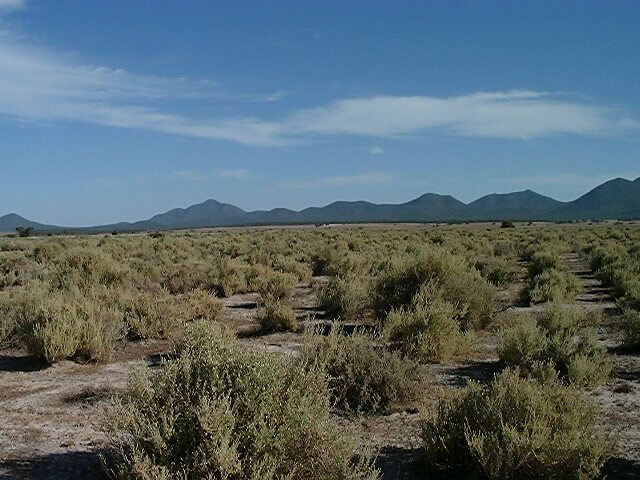
Legumes
[expand title=” ” swaptitle=” ” tag=”h4″ elwraptag=”div” elwrapclass=”expend-collapse-wrapper”]
Balansa clover (Trifolium michelianum) is an annual clover tolerant of Class 1 salinity. It has good tolerance to flooding because its stems are hollow, allowing oxygen to move down to the roots when the plant is partially submerged. The most popular variety, Bolta, flowers in mid November.
Persian clover (Trifolium resupinatum) is an annual clover tolerant of Class 1 salinity similar to Balansa, but is more tolerant of flooding. Cultivar Nitro flowers about two weeks later than the Bolta variety of Balansa.
Strawberry clover (Trifolium fragiferum) is a perennial legume tolerant of Class 1 salinity and waterlogging, but prefers alkaline soil. It is a weak seedling, but with sufficient moisture stays green through the summer. It generally does not persist in area with rainfall less then 550mm.
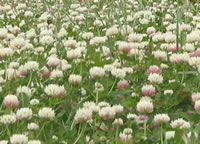
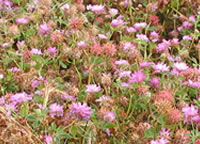
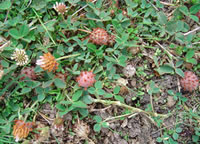
Some new salt tolerant legumes are on the horizon in the next few years. This includes messina (Melilotus siculus) which is a promising annual legume that is undergoing trials and looks to have salt tolerance greater than any existing commercial legume. There are also some varieties of lucerne that are reputed to have salt tolerance.
[/expand]
Sowing and establishment of introduced species on saline land
[expand title=” ” swaptitle=” ” tag=”h4″ elwraptag=”div” elwrapclass=”expend-collapse-wrapper”]
Like all perennials, good weed control is crucial to the successful establishment of saltland pastures. Sites should be grazed hard the year before and then spray topped in the spring before sowing.
Exact time of sowing will depend on whether it is a temperate or subtropical, however temperate grasses like tall wheat grass and puccinellia should be sown after the break once the first germination of weeds has come up and been sprayed. A double knock should be employed and the seed should then be planted generally less then 10mm. Press wheels should be used or roller. More detailed information can be found on the SALtland Genie site.
Saltbush species require a different approach. Either direct seeding or seedlings can be used and often a mixture of both can be effective. Generally saltbush is mounded and seeded or planted into the mound. In WA the use of a niche seeder has proven very effective. This creates as M shaped mound with the seed and vermiculite or seedlings planted in the groove or niche on top of the mound.
As with all pastures, weed and insect control is crucial. Sites to be planted to saltbush should be heavily grazed the year before and then spray topped. Knockdowns should be used prior to and at seeding and redmite control should be practiced. For further information see SALTland genie.
Sites should be soil tested to determine nutrient and pH status. Lime should be applied at least a year before establishment. It is highly recommended that sites are surveyed with an EM38, which should be available from your local NRM centre.
Saline sites are often variable so a mixture of pasture species can be a good option. Suggested sowing rates are shown in Table 2 for individual species with their corresponding salinity classes. Seeding rates for individual species should be decreased when seeding as part of a mix and increased when planted as a monoculture. The pasture mix should be sown in late March or April after opening rains (except for subtropicals). Spraying for red-legged earth mite is necessary to ensure successful establishment.
Table 2. Sowing rates for pastures on saline land
| Species | Seeding rate (kg/ha) | Salinity class |
| Year 1 | ||
| Tall wheatgrass (kg/ha) | 4-7 | 1-3 |
| Puccinellia (kg/ha) | 4-5 | 2-4 |
| Kikuyu | 2 | 1-2 |
| Rhodes grass | 2-3 | 1-2 |
| Tall fescue (kg/ha) | 7-14 | 1 |
| Strawberry clover (kg/ha) | 2-3 | 1 |
| Balansa clover (kg/ha) | 0.5 | 1 |
| Persian clover (kg/ha) | 0.5 | 1 |
| Year 2 | ||
| Balansa clover (kg/ha) | 1-2 | 1 |
| Persian clover (kg/ha) | 1-2 | 1 |
| Sub clover | 1-4 | 1 |
There are important differences in the agronomy of land at different salinity levels:
Class 1: Weed control is critical for these areas, and a second spraying may be required between opening rains and sowing. Balansa and Persian clover will be strong competitors to the sown grasses and should be sown at a low sowing rate. Alternatively, these legumes can be drilled in or spread with fertiliser in the following year, once the sown grasses have established.
Class 2: Plant germination is slower in Class 2 than Class 1. There are fewer weeds that compete with the pasture, and these emerge slowly. Legume growth is poor, so tall wheatgrass is more dependent on applied nitrogen to maintain vigour. Weed and insect control is however still essential.
Saltbush can be planted on these areas usually in alleys with salt tolerant perennial in the inter-rows. Often producers will sow the entire paddock to tall wheat grass first and then create the mounds and plant the saltbush.
Class 3: These areas have limited options with puccinellia based pastures along with dense saltbush stands probably the best bet. Establishment may be slow, so good weed control is important and fencing is critical to allow these sites to establish.
[/expand]
Grazing management
[expand title=” ” swaptitle=” ” tag=”h4″ elwraptag=”div” elwrapclass=”expend-collapse-wrapper”]
During the first growing season of a tall wheatgrass pasture, grazing should be light until November, to ensure plants are well anchored. After this, the pasture should be grazed when it reaches a height of 15cm, and grazed down to 3cm. Rotational grazing, a small paddock size, and large mob sizes are a good way to maintain the pasture in a vegetative state. Small areas should be fenced and managed separately to avoid under or overgrazing.
[/expand]
Drainage
[expand title=” ” swaptitle=” ” tag=”h4″ elwraptag=”div” elwrapclass=”expend-collapse-wrapper”]
Drainage of surface runoff reduces the stresses of flooding and waterlogging on plants, while also improving animal welfare by creating drier areas for them to stand and camp. Construction of drains that intercept saline groundwater may be subject to a notice of intent to drain and will need to be assessed by the Department of Agriculture. Surface water earthworks are not subject to this.
Interceptor drains divert surface water coming from higher up the slope.
W drains are useful in waterlogged flats and can be effective in removing surface water, especially when combined with herring bone spoon drains
Raised beds allow plants such as tall wheatgrass with less flooding and waterlogging tolerance to perform well on the beds, while the drains favour puccinellia. Raised beds also allow greater flushing of salts from the topsoil. The beds limit vehicle access, but allow livestock to avoid flooding during winter.
Note: Drainage should not be contemplated on Class 4 salinity unless the surface is already bare, because of difficulties in restoring vegetative cover after earthworks.
[/expand]
Further Information
- Saltland Genie
- Perennials rules of thumb
- Albany Eastern Hinterland, Wilson Inlet, Oyster Harbour and Esperance Sandplain catchment appraisal resource management technical reports
- Sustainable Grazing on Saline Land – Turning saline land into a profitable asset.
- Salinity Indicator Plants – A guide to spotting soil salting
- Soil-salinity Tolerant Plants – Western Victorian Region
- Land resources in the South-West Agricultural Region, A shire based summary of land degradation and land capability. Resource management technical report 330, Department of Agriculture and food WA, Dec 2008
- Lucerne guidelines for Western Australia. Bulletin 4785, Department of Agriculture and Food WA, Dec 2009

